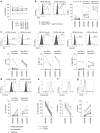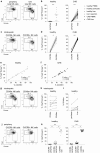CXCR6 marks a novel subset of T-bet(lo)Eomes(hi) natural killer cells residing in human liver
- PMID: 27210614
- PMCID: PMC4876507
- DOI: 10.1038/srep26157
CXCR6 marks a novel subset of T-bet(lo)Eomes(hi) natural killer cells residing in human liver
Abstract
Natural killer cells (NK) are highly enriched in the human liver, where they can regulate immunity and immunopathology. We probed them for a liver-resident subset, distinct from conventional bone-marrow-derived NK. CXCR6+ NK were strikingly enriched in healthy and diseased liver compared to blood (p < 0.0001). Human hepatic CXCR6+ NK had an immature phenotype (predominantly CD56(bright)CD16-CD57-), and expressed the tissue-residency marker CD69. CXCR6+ NK produced fewer cytotoxic mediators and pro-inflammatory cytokines than the non-liver-specific CXCR6- fraction. Instead CXCR6+ NK could upregulate TRAIL, a key death ligand in hepatitis pathogenesis. CXCR6 demarcated liver NK into two transcriptionally distinct populations: T-bet(hi)Eomes(lo)(CXCR6-) and T-bet(lo)Eomes(hi)(CXCR6+); the latter was virtually absent in the periphery. The small circulating CXCR6+ subset was predominantly T-bet(hi)Eomes(lo), suggesting its lineage was closer to CXCR6- peripheral than CXCR6+ liver NK. These data reveal a large subset of human liver-resident T-bet(lo)Eomes(hi) NK, distinguished by their surface expression of CXCR6, adapted for hepatic tolerance and inducible anti-viral immunity.
Figures




References
-
- Doherty D. G. et al.. The human liver contains multiple populations of NK cells, T cells, and CD3+CD56+ natural T cells with distinct cytotoxic activities and Th1, Th2, and Th0 cytokine secretion patterns. J Immunol 163, 2314–2321 (1999). - PubMed
Publication types
MeSH terms
Substances
Grants and funding
LinkOut - more resources
Full Text Sources
Other Literature Sources
Research Materials

